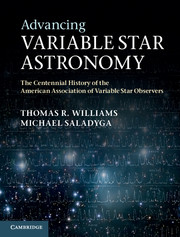 Advancing Variable Star Astronomy
Advancing Variable Star Astronomy Book contents
- Frontmatter
- Contents
- Foreword
- Preface
- Acknowledgments
- PART I PIONEERS IN VARIABLE STAR ASTRONOMY PRIOR TO 1909
- PART II THE FOUNDING OF THE AAVSO – THE WILLIAM TYLER OLCOTT ERA
- 3 The amateur's amateur
- 4 Amateurs in the service of science
- PART III RECORDING AND CLASSIFICATION – THE LEON CAMPBELL ERA
- PART IV THE SERVICE BUREAU – THE MARGARET MAYALL ERA
- PART V ANALYSIS AND SCIENCE – THE JANET MATTEI ERA
- PART VI ACCELERATING OBSERVATIONAL SCIENCE – THE ARNE HENDEN ERA
- Appendix A AAVSO historiographic notes
- Appendix B Top AAVSO observer totals
- Appendix C Variable star observing groups represented in the AAVSO International Database
- Appendix D AAVSO Awards
- Appendix E Officers of the AAVSO
- Appendix F AAVSO Council members
- Appendix G AAVSO Scientific committee, section, division, and program chairs
- Notes
- Bibliography
- Index
3 - The amateur's amateur
from PART II - THE FOUNDING OF THE AAVSO – THE WILLIAM TYLER OLCOTT ERA
Published online by Cambridge University Press: 13 June 2011
- Frontmatter
- Contents
- Foreword
- Preface
- Acknowledgments
- PART I PIONEERS IN VARIABLE STAR ASTRONOMY PRIOR TO 1909
- PART II THE FOUNDING OF THE AAVSO – THE WILLIAM TYLER OLCOTT ERA
- 3 The amateur's amateur
- 4 Amateurs in the service of science
- PART III RECORDING AND CLASSIFICATION – THE LEON CAMPBELL ERA
- PART IV THE SERVICE BUREAU – THE MARGARET MAYALL ERA
- PART V ANALYSIS AND SCIENCE – THE JANET MATTEI ERA
- PART VI ACCELERATING OBSERVATIONAL SCIENCE – THE ARNE HENDEN ERA
- Appendix A AAVSO historiographic notes
- Appendix B Top AAVSO observer totals
- Appendix C Variable star observing groups represented in the AAVSO International Database
- Appendix D AAVSO Awards
- Appendix E Officers of the AAVSO
- Appendix F AAVSO Council members
- Appendix G AAVSO Scientific committee, section, division, and program chairs
- Notes
- Bibliography
- Index
Summary
There is an effort being made to organize a Variable Star section in this Country. Prof. Pickering of the Harvard College Observatory favors the plan.
– William Tyler Olcott, letter to Harriet W. Bigelow, Professor of Astronomy, Smith College, October 4, 1911William Tyler Olcott's resignation as the leader of the Variable Star Section of the Society for Practical Astronomy in 1913 coincided with his efforts to form another variable star organization.
In the previous 2 years, Olcott had formed the American Association of Variable Star Observers (AAVSO), officially begun on October 10, 1911. Its existence inadvertently demolished the SPA's variable star section, whose members had left to join the AAVSO. Their migration may not have had anything to do with actions of the SPA's teenaged founders. What can be said, however, is that they remained with Olcott and the AAVSO after a year or more in correspondence with Olcott and recognition that Olcott and his AAVSO were connected in some way to the Harvard College Observatory (HCO).
This man of letters and science seemed ideally cast as the founder of a new organization. Even more so, he always seemed to have sufficient time and wherewithal to travel and support an international organization. This chapter follows Olcott's life leading up to his founding of the AAVSO and how he came to a privileged position.
- Type
- Chapter
- Information
- Advancing Variable Star AstronomyThe Centennial History of the American Association of Variable Star Observers, pp. 27 - 35Publisher: Cambridge University PressPrint publication year: 2011


